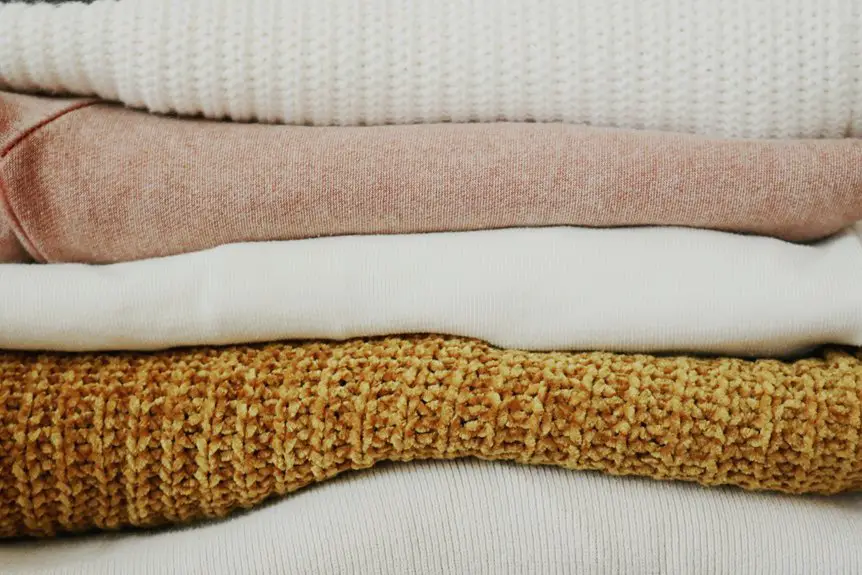To remove pilling from your towels and keep them soft, use a fabric shaver or lint remover to gently lift the pills. Wash your towels in cold water with a gentle detergent, avoiding fabric softeners, which can lead to more pilling. Air dry your towels or use a low heat setting to maintain their softness. By taking these steps, you can prolong the life of your towels. You’ll find additional tips to enhance your towel care.
Table of Contents
Key Takeaways
- Use a lint remover or fabric shaver to gently lift and remove pills without damaging the towel fibers.
- Regularly pluck stubborn pills with tweezers to maintain a smooth towel surface.
- Wash towels separately in cold water with gentle detergent to reduce friction and prevent new pilling.
- Avoid fabric softeners; instead, use white vinegar in the wash for added softness without pill buildup.
- Air dry towels or use a low heat setting to prevent fiber damage and maintain softness.
Understanding Towel Pilling: Causes and Effects
Pilling on towels is a common issue that can affect their appearance and softness. When you notice those little fuzzy balls forming, it’s usually due to friction from washing or drying, wear and tear, or low-quality fibers.
The more you use and wash your towels, the more likely they’ll pill. Cotton towels, for example, are prone to this because of their looped structure. It’s frustrating to see your favorite towels lose their smooth feel, but understanding the causes helps you take preventive measures.
Additionally, pilling can make your towels feel rougher against your skin. By recognizing these factors, you can better appreciate the importance of proper care and maintenance to keep your towels looking and feeling fresh.
Washing Techniques to Minimize Pilling
To keep your towels looking their best, you’ll want to adjust your washing techniques.
Start by using gentle detergents and washing in cold water to reduce wear.
Plus, skipping fabric softeners can help minimize pilling, ensuring your towels stay soft and fluffy.
Use Gentle Detergents
While you might be tempted to use strong detergents for a deep clean, opting for gentle detergents can greatly reduce pilling on your towels.
Harsh chemicals can damage the fibers, leading to more pilling over time. By choosing a milder detergent, you help maintain your towels’ softness and longevity.
Here are three benefits of using gentle detergents:
- Fiber Protection: Gentle formulas preserve the integrity of towel fibers, reducing wear and tear.
- Less Residue: They leave behind minimal residue, preventing buildup that can cause pilling.
- Skin-Friendly: Gentle detergents are often free from harsh additives, making them safer for sensitive skin.
Switching to a gentle detergent is a simple yet effective way to keep your towels looking and feeling their best.
Wash in Cold Water
Using gentle detergents sets the stage for better towel care, but the way you wash them also plays a significant role in minimizing pilling.
When it comes to washing towels, opt for cold water. Cold water not only helps preserve the fibers but also reduces friction during the wash cycle, which can lead to pilling. Warm or hot water can weaken the fabric, causing those annoying little balls to form.
Make sure to select a gentle cycle to further protect your towels. This simple change can extend the life of your towels and keep them feeling soft and cozy.
Avoid Fabric Softeners
Although fabric softeners are often marketed as a way to enhance the softness of your towels, they can actually contribute to pilling. These products coat the fibers, making them less breathable and prone to wear.
Instead, consider these alternatives:
- Vinegar: Add half a cup of white vinegar to your rinse cycle. It helps break down detergent residues and softens fabric naturally.
- Baking Soda: Incorporate baking soda into your wash. It softens your towels and helps maintain their color and texture.
- Dryer Balls: Use wool dryer balls in the dryer to minimize static and reduce drying time, keeping your towels fluffy without chemicals.
Drying Methods for Maintaining Towel Softness
To keep your towels soft and fluffy, it’s essential to pay attention to how you dry them. Instead of tossing them in the dryer on high heat, use a low heat setting. This helps prevent damage to the fibers while still guaranteeing they dry effectively.
Adding a few clean tennis balls or dryer balls can also fluff them up during the drying process. If you prefer air drying, hang your towels outside in a shaded area to avoid sun damage, which can make them stiff.
If air drying indoors, provide good ventilation to prevent mildew. Avoid over-drying, as this can lead to roughness. By following these methods, you’ll maintain your towels’ softness longer.
Manual Removal of Pilling: Tools and Techniques
When you notice pilling on your towels, addressing it promptly can help restore their original texture.
Manual removal techniques are effective and can be done with minimal tools. Here are three items you’ll need to tackle pilling:
- Lint Remover: A handheld lint remover can easily lift and remove those pesky pills, making your towels look refreshed.
- Fabric Shaver: This tool gently shaves off the pills without damaging the towel fibers, ensuring a smooth finish.
- Tweezers: For stubborn pills, a pair of tweezers can help you pluck them away individually, allowing for precision.
Using these tools, you can effectively manage pilling and keep your towels feeling soft and cozy.
Preventive Measures to Keep Towels Pill-Free
While you can effectively remove pilling from towels, preventing it in the first place is even better.
To keep your towels pill-free, start by washing them separately or with similar fabrics. Use a gentle cycle and cold water to minimize friction. Avoid using fabric softeners, as they can contribute to pilling. Instead, try white vinegar for added softness without the buildup.
When drying, opt for low heat to reduce wear and tear; air drying is even better. Also, limit the use of rough surfaces, like bath mats, when drying off.
Finally, store your towels in a cool, dry place to prevent moisture-related issues. Following these steps will help maintain your towels’ softness and appearance for longer.
When to Replace Your Towels
Knowing when to replace your towels can save you from using worn-out fabric that doesn’t absorb moisture effectively.
Look for signs like fraying edges, thinning material, or persistent pilling that indicate it’s time for a change.
Keep in mind that the lifespan of bath towels can vary based on their quality and how often you use them.
Signs of Worn Towels
Towels play an essential role in your daily routine, so it’s important to recognize the signs of wear that indicate it’s time for a replacement.
If you notice any of the following signs, it might be time to invest in new towels:
- Increased Absorbency Issues: If your towels no longer absorb water effectively and leave you damp after use, they’re likely worn out.
- Visible Wear and Tear: Look out for frayed edges, holes, or thinning fabric. These signs indicate that the towel’s integrity is compromised.
- Persistent Odors: If your towels have a musty smell that doesn’t go away after washing, it’s a clear sign they’ve reached the end of their lifespan.
Pay attention to these signs to guarantee you always have soft, effective towels.
Lifespan of Bath Towels
Recognizing the signs of worn towels can help you decide when it’s time for an upgrade. Typically, bath towels last about 2 to 5 years, depending on usage and care. If you notice persistent pilling, fraying edges, or a rough texture, it’s likely time to replace them.
Here’s a quick reference table to help you assess your towels:
| Sign of Wear | Action Needed | Replacement Timeframe |
|---|---|---|
| Pilling | Remove pilling | 2-3 years |
| Fraying Edges | Trim or replace | 3-5 years |
| Rough Texture | Replace | 2 years |
Material Quality Considerations
When contemplating whether to replace your towels, the quality of the material plays an essential role in their longevity and performance. High-quality towels not only feel better but also last longer, reducing the need for frequent replacements.
Here are three key indicators to help you decide when it’s time for new towels:
- Pilling: If your towels are covered in pills and feel rough, it’s a sign of deteriorating fabric quality.
- Absorbency: When towels lose their ability to absorb water effectively, it’s time to think about buying a replacement.
- Fading: If your towels have lost their vibrant color and look worn out, they may no longer provide the aesthetic appeal you desire.
Keeping these factors in mind will help you maintain a cozy and functional bathroom.
Frequently Asked Questions
Can I Use a Lint Roller to Remove Pilling?
Yes, you can use a lint roller to remove pilling. Just roll it over the fabric’s surface, and it’ll pick up those pesky pills. It’s a quick and easy solution to keep your items looking fresh.
What Types of Towels Are Least Likely to Pill?
When choosing towels, opt for those made from long-staple cotton or bamboo. These materials resist pilling better than others. Avoid lower-quality fabrics, and you’ll enjoy softer, longer-lasting towels that maintain their appearance.
Is It Safe to Iron Towels to Remove Pilling?
Ironing towels to remove pilling isn’t just risky; it’s like trying to tame a wild stallion. You’ll likely damage the fabric instead. Stick to safer methods to keep your towels soft and inviting.
How Often Should I Wash My Towels to Prevent Pilling?
You should wash your towels every three to four uses to prevent pilling. Using a gentle cycle and avoiding fabric softeners can help maintain their softness and reduce friction that leads to pilling.
Do Fabric Softeners Help Reduce Towel Pilling?
When it comes to towel care, you might find fabric softeners can help reduce pilling, but they also coat fibers. So, you’ll want to strike a balance to keep your towels feeling plush and soft.
- Kevlar Cloth (DuPont): Specifications and Industrial Uses - June 21, 2025
- Kevlar Class IIIA Fabric: Ballistic Protection Explained - June 21, 2025
- Kevlar Carbon Fiber in China: Market Analysis and Reviews - June 21, 2025







